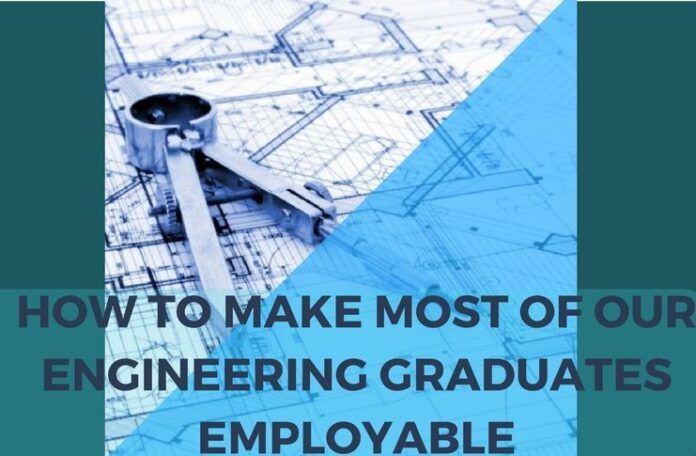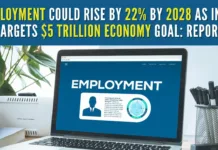
Quality education in Engineering may help in getting better employment
[dropcap color=”#008040″ boxed=”yes” boxed_radius=”8px” class=”” id=””]I[/dropcap]ndia had less than 50 Engineering Colleges in 1947 and a little over 100 in 1965. Around the turn of the century, engineering education was opened up for privatization massively. There are over 3,500 engineering colleges today, but there is a high percentage of unemployment and un-employability among the 4 lakhs engineering graduates passing out annually.
We need to acknowledge that engineering colleges set up with a profit motive and low fees dictated by the Government can’t invest heavily in infrastructure and human resources. So, we need cost-effective solutions.
So, the policy of opening so many engineering colleges has often come in for criticism. Those who criticize many not be aware that, even in the 70s, there was unemployment and un-employability among the few thousand engineering graduates we produced.
Today, there are excellent engineering graduates coming out of some good colleges, and some even from the ‘not so good’ (euphemistically called ‘Mata Pita’) engineering colleges; some of them get employed abroad and in India, mostly in IT sector and MNCs.
Had engineering education not been opened up, most of these youth would have done B.Sc/ BA, and struggling for jobs today, competing for Government jobs even as clerks. It is just the opportunity space created by the engineering colleges that has helped them come up roaring well in life.
[dropcap color=”#008040″ boxed=”yes” boxed_radius=”8px” class=”” id=””]A[/dropcap]lso, we used to have unrest due to reservations till the 90s, creating tensions among youth of different castes, especially with lakhs of youth competing for the few thousand engineering seats. Opening up of engineering education meant that everyone got admission in some engineering college. This has completely squelched the tensions.
It’s also true that most engineering graduates are not employable (and/ or not employed), and some are grossly under-employed. But without these private engineering colleges, we would have had heightened problem of unemployment, less GDP and nationwide unrest due to the reservation.
This article suggests how to improve the quality of our engineering education and make most of our engineering graduates employable.
We need to acknowledge that engineering colleges set up with a profit motive and low fees dictated by the Government can’t invest heavily in infrastructure and human resources. So, we need cost-effective solutions.
What are the factors that contribute to higher quality of education and employability?
• Quality & Diversity of Student Intake
• Quality of Teaching
• Industry Involvement
• Infrastructure
• Research
[dropcap color=”#008040″ boxed=”yes” boxed_radius=”8px” class=”” id=””]Q[/dropcap]uality & Diversity of Student Intake: While every effort must be made to improve the quality of student intake, we should recognize that when we seek to produce engineers on a large scale, there are bound to be limitations on this front, until we improve our school education system.
The cost of these video and animations for all classes (Year 1-4), all streams, when shared by all the colleges, will work out to be negligible say Rs 5-10 lakhs per college per year
Since the students admitted by the top ranking engineering colleges are crème de la crème and they have also imbibed soft skills genetically and/ or developed due to their socio-economic background, their level of employability is intrinsically high. Hence, they usually secure jobs top paying jobs.
To the lower rung students, we can offer placement-oriented Spoken English and Personality & Attitudinal Development Training all through the 4 years in small doses of 1-2 hours a week, which will make a far better impact than crash courses in the Final Year.
In our context, we could interpret diversity to mean the mix of students from across India, with reservation and women’s participation.
The quality of Teaching: A cost-effective teaching pedagogy is proposed, based on the successful experience of a PG Distance Management Education program tried out two decades back.
[dropcap color=”#008040″ boxed=”yes” boxed_radius=”8px” class=”” id=””]M[/dropcap]any of our engineering teachers are either not well-versed in their subjects, or are not good teachers, or both. The idea is to create all the lessons in video form delivered by top Professors from IITs, NITs, etc., and using animation to illustrate concepts. The Class teachers will anchor the video and animation lessons, and facilitate Group Discussions and objective ‘end of lesson online evaluation’.
It should be less challenging today (with so many advances in technology) in engineering (which is more suitable for rendering in this form than management education). The classes will be livelier than at present and the subjects better understood.
To deliver lessons in video and animation formats, each classroom should be fitted with LCD/ LED Projector.
We can divide a typical session of 1 hour (effectively 50’) into the following 4 activities:
• 5’ Group Discussions, typically at the start of each lesson to introduce the subject
• Showing the lesson in 3-10’ video and animation clips (as explained above)
• Anchoring the session, breaking the monotony, filling in with clarifications.
• 5’-10’ Evaluation (random online questions from a data bank, on the day’s learning)
We can also give the students access to the video and animations for review, after class.
The cost of these video and animations for all classes (Year 1-4), all streams, when shared by all the colleges, will work out to be negligible (say Rs 5-10 lakhs per college per year), without subsidizing. It could make a dramatic difference to the quality of teaching and learning.
Industry participation: Once Industry recognizes that efforts are on to improve the quality of engineering education and they could recruit reasonable quality of engineers soon, they are likely to involve themselves in the activities of the local engineering colleges.
Infrastructure: There are already norms for this, and they can be tweaked to ensure that minimum infrastructure is available in every college. We need not set unrealistically high standards, but the Government could consider setting up common Infrastructure in a few cities to be used by the engineering colleges on a shared basis.
Research: Since our engineering colleges are not designed to be research bodies, we need not reckon this as a factor.
[dropcap color=”#008040″ boxed=”yes” boxed_radius=”8px” class=”” id=””]T[/dropcap]he outlook for the national economy is bright, and the Government’s ‘Make in India’ policy will make things better. Hence, many engineering students would make good use of this opportunity to further their career prospects. Once they know they are getting a reasonably good quality education, and they are likely to get good jobs if they do well in their studies, their personal efforts would at least partly make up for any deficiency in their innate abilities. Involving parents, and with regular feedback using technology (say, mobile phones using part of the process), we can ensure that students make the best use of this opportunity.
‘Proof of Concept’ and Pilot Project can be done before we go full steam ahead.
Once we succeed in this, we can extend it to other streams, like Medicine, Law, Management, etc and even non-professional education like Arts, Science, Commerce, etc. subject to viability. We can even extend it to school education.
“If we always do what we’ve always done,
We’ll always be where we’ve always been”
Note:
1. The views expressed here are those of the author and do not necessarily represent or reflect the views of PGurus.
- How BJP can get 33%+ vote share in TN - April 1, 2024
- A transparent, equitable electoral funding alternative - March 19, 2024
- How TN BJP can come to No. 1 or No. 2 in 2024 LS polls - January 11, 2024











This is a serious concern area. Your article throws up very interesting ideas to improve the average student outcomes from engineering colleges. Are any being actioned for proof of concept as you have said?